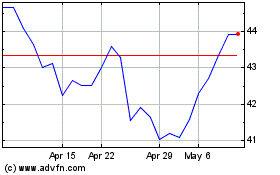By Robert Wall and Daniel Michaels
When Airbus SE launched the A380 superjumbo in 2000, it touted
the two-deck plane as "the Eighth Wonder of the World." Instead,
the world's largest passenger plane exposed dysfunction inside the
European aerospace company and now offers a textbook case of a
company misjudging its market and losing big.
Airbus has sunk at least $17 billion into the project yet sold
fewer than half of the 750 superjumbo jetliners it promised to
deliver by the end of this year. On Thursday Airbus said it would
cease producing the 555-seat plane at the end of 2021.
By then, Airbus expects to have sold 251 A380s -- one more than
its original break-even target, set before production delays added
billions of dollars in costs. At its peak, A380 deliveries never
reached 5% of annual Airbus deliveries -- less than half its
target.
How did some of the world's best engineers get their numbers so
wrong? Airbus misjudged market trends and underestimated emerging
technologies. It compounded the error by justifying its decision
with emotion and European pride, some former Airbus officials have
said. Then its production system, organized for politics more than
efficiency, failed.
Steven Udvar-Hazy, a pioneer of aircraft-leasing who was early
both to order the A380 and terminate his planned purchase, said the
plane was inspired largely by political ambition to out-do Boeing
Co.'s 747 jumbo jet as the world's largest airliner.
"The technological achievement was formidable," he said, but the
A380's "commercial viability was always dubious."
All jetliners are expensive bets on technology, engineering and
market trends. When Boeing's 747 first flew in 1969, it was triple
the size of any other plane in the air and for several years its
success was uncertain. Europeans in the 1960s wagered on the
government-funded supersonic Concorde, an aviation marvel that
flopped because of high operating cost and house-rattling
noise.
Airliners typically fly for a generation, but the first A380s
are already parked after only about a decade and being sold for
scrap. Boeing's jumbo jet could still be in production -- though
barely -- when Airbus mothballs its A380 factories.
"We were probably at least 10 years too late," Airbus Chief
Executive Tom Enders said in announcing the A380 cancellation.
With the A380, Airbus planners bet prevailing market conditions
would persist. They assumed airlines would keep using big,
increasingly congested hub airports to transfer passengers between
connecting flights, and need to fly large, four-engine jetliners on
very long routes. Both changed around the time A380s started
flying.
Not long after Airbus began developing the A380, Boeing in 2003
embarked on its smaller, hyper-efficient twin-engine 787
Dreamliner. It quickly became a best seller. Only in 2006 did
Airbus respond with a big two-engine model, the A350. Together, the
twins rewrote the economics of long-haul flying, hurting the
A380.
The technology change coincided with shifts in airline
boardrooms. Whipsawed by traffic-crushing crises and soaring fuel
prices, airline executives in the 2000s focused increasingly on
costs and investor returns. Profit took precedence over market
share. Big planes that could be tough to fill profitably fell from
favor. No U.S. carrier bought the A380. The biggest European buyer,
Germany's Deutsche Lufthansa AG, took only 14.
Airbus officials offered many reasons for the order dearth,
including production problems and the financial crisis. Yet they
insisted airport congestion would snarl growth that only the A380
could revive. In 2015, after another order drought, Fabrice
Bregier, then-Airbus Commercial Plane president, said the A380 was
simply ahead of its time.
The A380 might have built more momentum if not for production
debacles. Around the time of the first test flight in 2005, Airbus
realized it had underestimated the complexity of wiring the
superjumbo. Managers discovered that French and German designers
had used incompatible software.
The snafu exposed deep cultural rifts inside the planemaker,
which was led by French and German co-CEOs -- a structure designed
to appease government shareholders. In 2006, during the depth of
the A380 crisis, Airbus ousted senior French and German executives.
The next year it abandoned the co-CEO structure altogether.
More setbacks followed. The engine of an A380 blew up during a
passenger flight in 2010. Nobody was hurt, but it drew negative
attention to the plane. Wing cracks discovered on many A380s led to
costly repairs.
Customers, including Richard Branson's Virgin Atlantic Airways
Ltd., Air France-KLM SA and Qantas Airways Ltd., canceled
orders.
Airbus stumbled into its production fiasco because of
overconfidence in its own abilities, company veterans said later.
That hubris was fueled by giddiness from politicians and executives
at the turn of the century about the plane maker itself and the
Europe Union.
Airbus was created in 1969 as a loose consortium of European
aerospace companies. After a slow start, by the late 1990s it had
squeezed McDonnell-Douglas out of the market and was nipping at
Boeing's heels.
The corporate champions fit with the growing stature of the EU,
created in 1993, and its single currency, the euro, which debuted
in 1999. When the Airbus partners announced their merger in October
1999, it was unveiled by French Prime Minister Lionel Jospin and
German Chancellor Gerhard Schroeder.
"Europe has succeeded with the great feat of the euro," said
French Finance Minister Dominique Strauss-Kahn at the ceremony.
Integrating Airbus "is a euro of industry."
Fusing Airbus was deemed a prerequisite for undertaking a
project so ambitious as a superjumbo, which in turn would bond the
partners, said Jean-Luc Lagardere, who was co-chairman of Airbus's
holding company.
"This aircraft will be the cement of the company for years to
come," Mr. Lagardere said when Airbus launched the A380 in June
2000.
Write to Robert Wall at robert.wall@wsj.com and Daniel Michaels
at daniel.michaels@wsj.com
(END) Dow Jones Newswires
February 19, 2019 13:20 ET (18:20 GMT)
Copyright (c) 2019 Dow Jones & Company, Inc.
Airbus (PK) (USOTC:EADSY)
Historical Stock Chart
From Aug 2024 to Sep 2024

Airbus (PK) (USOTC:EADSY)
Historical Stock Chart
From Sep 2023 to Sep 2024
